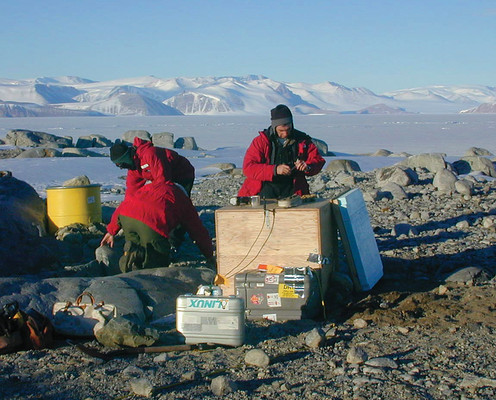
by Erin Wayman Thursday, January 5, 2012

Researchers install the seismographs in Antarctica at detected seismic waves from the Whillans Ice Stream. Douglas Wiens
The Whillans Ice Stream — an Antarctic glacier that covers an area slightly smaller than the state of New Jersey — flows from the interior of the continent to the ocean at a rate of about one meter per day. That’s not unusual for a large glacier, but how it covers that distance is surprising. Instead of inching along at a steady pace as most glaciers do, the Whillans Ice Stream jerks forward just twice a day, each time sending out seismic waves equivalent to a major earthquake. Now scientists say they know why — a “sticky spot” under the ice causes the glacier to stall for a while and then suddenly slip.
In 2001, seismologist Douglas Wiens of Washington University in St. Louis installed 43 seismographs in Antarctica’s Transantarctic Mountains to study the mountains’ structure. But when he analyzed his data, Wiens found seismic signals coming from as far away as 1,000 kilometers. “We didn’t know what was causing them,” he says. “Our initial thought was that these might be regular earthquakes in the ground until we saw that they all came from the same spot.
That spot was on the Whillans Ice Stream, a glacier 600 meters thick. Previous GPS observations showed that the ice stream sits still for most of the day and then, twice daily, advances anywhere from 40 to 70 centimeters during a 10- to 20-minute period. Throughout that period, the movement sends out seismic waves similar to a magnitude-7 temblor, but people standing on top of the Whillans Ice Stream never feel the glacial quake. “Most earthquakes happen in a few seconds,” says Sridhar Anandakrishnan, a glaciologist at Pennsylvania State University in University Park. “This one happens so slowly that you don’t get violent shaking.”
Exactly what causes the twice-daily movement, however, was still a mystery. So, Wiens, Anandakrishnan and two colleagues teamed up to investigate the phenomenon more closely. They discovered that the ice stream’s jerky motions seem to originate from the same point: an approximately eight-kilometer-wide patch of greater friction under the ice stream that’s about 130 kilometers from where the glacier flows into the Ross Sea, the team reported June 5 in Nature. Using simultaneous seismic and GPS observations, they determined the Whillans Ice Stream’s movements mimic an earthquake rupture.
As the ice stream moves, the ice gets hung up on the rough spot (researchers don’t know for sure what causes the friction). The ice stream’s halt is also part tidally induced. When the tide comes in, the influx of water lifts the glacier’s downstream end, tilting the glacier and causing resistance that further impedes the glacier’s movement, Wiens says. Meanwhile, the glacier’s upstream end continues to flow. With nowhere to go, the stress builds up at the sticky spot like a spring being compressed, Anandakrishnan says. When the tide recedes and the ice drops, the sticky spot slips and the glacier lurches forward again.
This research “helps us identify where this bizarre behavior originates,” says Robert Bindschadler, chief scientist at the Hydrospheric and Biospheric Sciences Laboratory at NASA’s Goddard Space Flight Center in Greenbelt, Md. But to better understand the mechanics driving the sticking, Bindschadler says researchers should drill a hole into the sticky spot and place sensors in it to collect additional measurements.
Anandakrishnan has proposed studying the problem from another angle: using seismic surveys to image the sticky spot and determine its source of friction. Previous work indicates the spot could be an area with less water available to lubricate the ice; alternatively, Wiens says, a rough rocky patch could be to blame.
© 2008-2021. All rights reserved. Any copying, redistribution or retransmission of any of the contents of this service without the expressed written permission of the American Geosciences Institute is expressly prohibited. Click here for all copyright requests.